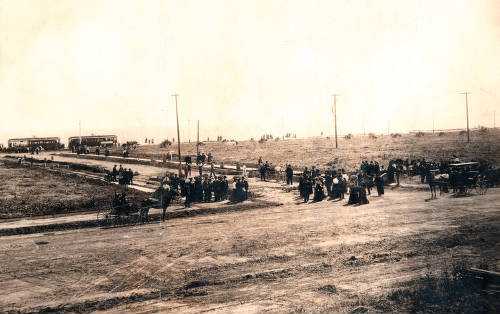CLAUDINE BURNETT BOOKS
Rancho Los Alamitos – Part 4: From Crops to Cottages
By Claudine Burnett
This is the last of a four part series on the history of the Rancho Los Alamitos. Part three told of the partnership which John W. Bixby, I. A. Hellman and the Flint-Bixby Company (comprised of Jotham & Lewellyn Bixby and Thomas Flint) entered into in July 1881, to develop the rancho. The purpose of the newly organized J. W. Bixby & Company was to raise and trade in cattle, sheep, horses and other stock, including wool raising, dairy business, and pasturing animals. Their goals were soon to expand in a new direction.
With the completion of the second transcontinental railroad in 1885, a price war developed between the new Santa Fe and the older Southern Pacific, bringing the cost of a ticket to California down to almost nothing. These railroad wars brought new investors to Southern California resulting in rapid development and financial gain. It was time to subdivide the Rancho Los Alamitos, under a new name — the Alamitos Land Company.
On September 1, 1886, advertisements about a new town, Alamitos Beach, began appearing in the Los Angeles Times:

Alamitos Beach is an extension of Long Beach on the East. Together, they are destined to form the unrivaled seaside resort of the world. Already the Long Beach Methodist Association and the Chautauqua Assembly of Southern California are permanent establishments. The Y.M.C.A. the “summer school of all sciences,” and the Temperance Camp Meeting people are seeking permanent homes in this beautiful “City by the Sea.” Alamitos Beach is the only beach in Los Angeles County where lots are laid out on the bluff and extend to the Pacific Ocean. Lots on the bluff side of Ocean Avenue are 55 x 180 feet. Prices, corners, $1000 ($33,400 in 2023); inside, $800 ($26,700). North side of Ocean Avenue, corners (45 x 100 ft.), north side of Ocean Avenue, inside (55 x 100 ft.) — price, each, $600 ($20,000). We will sell the above lots until Sept. 15, 1886, at a reduction of $100 ($3,340) per lot.
Captain Charles T. Healey, who surveyed the original Willmore City townsite (later to become Long Beach) in 1882, also laid out the new Alamitos townsite in 1886. The dividing line between Rancho Los Cerritos and Rancho Los Alamitos was present day Alamitos Boulevard, and on the other side of the boundary with Long Beach John Bixby and his associates began selling land.
The townsite was 20 blocks in length, from west to east. From Ocean Avenue, it extended two blocks toward the north and 39 blocks, only four lots wide, were laid out on the south side of the avenue. Between these little blocks the streets were designated as “places.” Spanish names were given to the cross streets, in alphabetical order, though George Bixby, son of Jotham Bixby, named some of the new east and west streets after several of his college friends.

Another endeavor of the Alamitos Land Company was subdividing Signal Hill. The syndicate subdivided all of Signal Hill except for a hundred acres on the eastern face which they believed too steep for housing, and sold off the lots on Signal Hill for around $100 ($3,740 in 2023) to $250 ($9,360) each. In the 1920s these lots produced hundreds of thousands of dollars in oil, bringing a great deal of money to those who had purchased property on the Hill. Because the eastern slope was too steep the Alamitos Land Company leased it to the Shell Oil Company, which discovered oil on the site. The royalties received by the heirs of the three original owners, from those hundred acres, made them very wealthy indeed.
−−−
In his March 28, 1939, Did You Know That? column Walter Case told of an interview with Martha Hathaway in which she shared memories about Alamitos Beach. Martha remembered her young brother-in-law, John W. Bixby, inviting her to drive with him to his new Alamitos Beach subdivision. Along the way from Rancho Los Alamitos, they encountered one lone sheepherder who, with the assistance of his dogs, was moving his 1000 sheep from one camp to another. She also recalled that there was not a single tree between the ranch house and the sea. Eventually, John Bixby stopped at the present site of Bixby Park and whistled shrilly. All at once a shadowy outline of a male figure appeared through the fog and a man emerged who was introduced to Miss Hathaway as Mr. Messick, superintendent of the new park. The two men drew spades, other garden tools and canvas covered green plants from the wagon. They disappeared into the silent, barren spaces to plant cypress and eucalyptus trees to transform the bleak terrain into a more hospitable environment. (Contrary to public belief, Bixby Park, first called Alamitos Park, was named after Jotham Bixby not John).
John W. Bixby died May 3, 1887, at the age of 38, from appendicitis. Plans were already underway before John’s death, to form another corporation — the Alamitos Land Company. On January 27, 1888, the new company, comprised of the Flint-Bixby Company, I. W. Hellman and John’s heirs, was incorporated. After the acreage designated for real estate development had been set aside under the newly formed corporation, the rest of the Rancho Los Alamitos was appraised and surveyed. Each partner ended up with one-third. I. W. Hellman received the land along the coast, and Jotham Bixby & Company took the inland section. John’s heirs received the central part, including the house and barns.
Much of the original 26,950-acre rancho would continue to support agriculture, but further subdivisions and hopes for a large harbor loomed in the future.